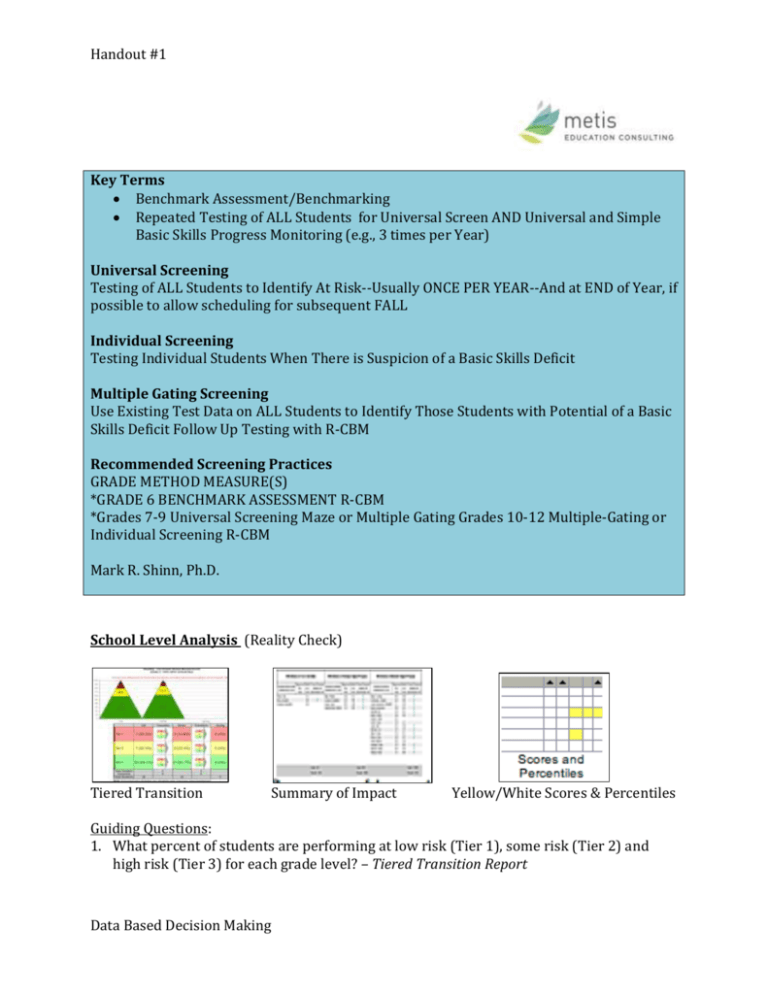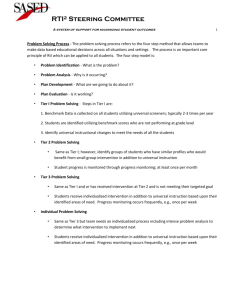Handout #1 Key Terms Benchmark Assessment/Benchmarking
advertisement

Handout #1 Key Terms Benchmark Assessment/Benchmarking Repeated Testing of ALL Students for Universal Screen AND Universal and Simple Basic Skills Progress Monitoring (e.g., 3 times per Year) Universal Screening Testing of ALL Students to Identify At Risk--Usually ONCE PER YEAR--And at END of Year, if possible to allow scheduling for subsequent FALL Individual Screening Testing Individual Students When There is Suspicion of a Basic Skills Deficit Multiple Gating Screening Use Existing Test Data on ALL Students to Identify Those Students with Potential of a Basic Skills Deficit Follow Up Testing with R-CBM Recommended Screening Practices GRADE METHOD MEASURE(S) *GRADE 6 BENCHMARK ASSESSMENT R-CBM *Grades 7-9 Universal Screening Maze or Multiple Gating Grades 10-12 Multiple-Gating or Individual Screening R-CBM Mark R. Shinn, Ph.D. School Level Analysis (Reality Check) Tiered Transition Summary of Impact Yellow/White Scores & Percentiles Guiding Questions: 1. What percent of students are performing at low risk (Tier 1), some risk (Tier 2) and high risk (Tier 3) for each grade level? – Tiered Transition Report Data Based Decision Making Handout #1 2. What does instruction and the classroom settings look like in grade levels and classrooms in which there are a high percent of students who are low risk? What occurred in previous grades to prepare the students? How can this be replicated? 3. What could be implemented in grade levels/classrooms in which there is a high percent of struggling students? What occurred in previous grades to prepare the students? Analyze the problem (possible reasons/hypotheses). Develop and implement solutions based on hypothesis. 4. What percent of students at the low risk level (Tier 1) remained at or above target in each grade? What percent of students transitioned to a lower level of risk (i.e., Tier 3 to Tiers 1/2, Tier 2 to Tier 1) or to a higher level of risk (i.e., Tier 1 to Tiers 2/3, Tier 2 to Tier 3) at each grade? Is tiered instruction having a positive affect on student outcomes? – Winter & Spring Summary of Impact Report; Yellow/White Scores & Percentiles Report If yes, continue what you are doing. If no, analyze the problem (possible reasons/hypotheses for the problem). Develop and implement solutions based on those hypotheses. 5. Considering AIMSweb data and other available information, what structures and professional development are needed to achieve positive outcomes for students Grade/Class Level Analysis (Resource Allocation) Tiered Transition Rainbow Report Instructional Rec (K-1) Quadrant Analysis Summary of Impact Guiding Questions: 1. Is Tier 1 instruction meeting the needs of the majority of students (75-80%) in our grade level? – Tiered Transition Report a. If yes, continue what you are doing. b. If no, analyze the problem (possible reasons/hypotheses for the problem) and determine how to adjust Tier 1 instruction to meet the needs of most students. Data Based Decision Making Handout #1 2. What are the instructional needs of students? Are there groups of students with similar needs? Given this information, how will we meet the needs of students at Tiers 1, 2 & 3? Reading-CBM Quadrant Analysis with the Criterion Referenced Rainbow Report AIMSweb CCSS M-CAP Report AIMSweb Instructional Recommendations Report Other available data (e.g., historical information, grades, assignments, program assessments, SBA, HM Phonics Screener, DRA, English language proficiency, attendance, office discipline referrals etc.) 3. Which student’s should be targeted for additional intervention and/or differentiated instruction? – Norm Referenced Rainbow Report a. Students > 25th percentile should receive differentiated Tier 1 instruction based on student needs (refer to 1b) b. Students scoring from the 11th percentile to the 24th percentile should be considered for Tier 2 intervention in addition to Tier 1 instruction c. Students < 10th percentile should be considered for Tier 3 intervention in addition to or in place of Tier 1 instruction 4. Are Tier 2 and Tier 3 intervention groups closing the achievement gap for students? – Winter & Spring Summary of Impact Report a. If yes, continue what you are doing. b. If no, analyze the problem (possible reasons/hypotheses for the problem) and determine how to adjust interventions to meet the needs of students. Student Level Analysis (Individual Problem Solving) Box & Whiskers ELL Performance Profile Progress Monitoring Guiding Questions: 1. What is the student's performance compared to the grade level target for success? Is the student at or above the target? – Box & Whiskers Report a. If yes, continue what you are doing (Note: if student is far above, consider enrichment). b. If no, what is the student's performance compared to grade level peers at that school? – Box & Whiskers Report If performance is similar to peers (i.e., > 25th percentile), focus on systematic and Data Based Decision Making Handout #1 explicit Tier 1 instruction. If performance is below the average range (i.e., < 25th percentile), focus on intensifying instruction to match the needs of the student (i.e., Tier 1 instruction + Tiers 2 or 3 intervention). Additional diagnostic assessment may be needed. c. If ELL, what is the student’s performance compared to grade level peers at the same level of English language proficiency? – ELL Performance Profile If performance is similar to peers, continue to provide systematic and explicit reading instruction in addition to English language instruction. Check to make sure the student is making adequate growth with English language acquisition (ACCESS). If performance is below peers, intensify reading instruction to match the needs of the student. Check to make sure the student is making adequate growth with English language acquisition (ACCESS). Additional diagnostic assessment may be needed. 2. Is the student making adequate growth in response to Tier 2 or 3 interventions? Are we closing the achievement gap? – Progress monitoring Report, Targets for Success, & National Norm Table a. If yes, continue or fade the intervention. b. If no, analyze the problem (possible reasons/hypotheses for the problem) and decide how to adjust the instruction/intervention to accelerate learning. Additional diagnostic testing may be needed. Data Based Decision Making






